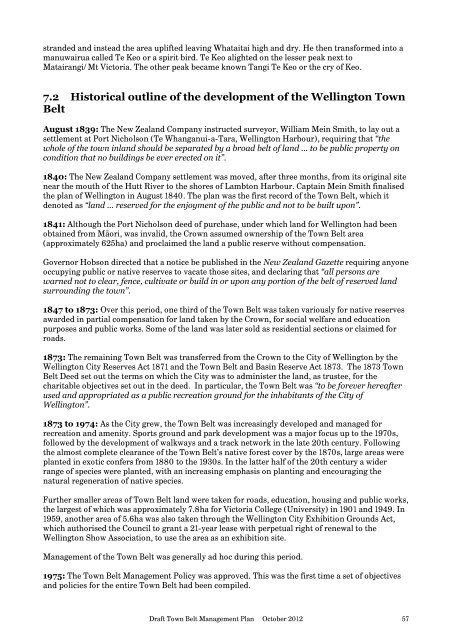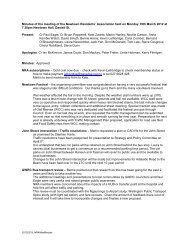Draft Town Belt Management Plan - Wellington City Council
Draft Town Belt Management Plan - Wellington City Council
Draft Town Belt Management Plan - Wellington City Council
Create successful ePaper yourself
Turn your PDF publications into a flip-book with our unique Google optimized e-Paper software.
stranded and instead the area uplifted leaving Whataitai high and dry. He then transformed into a<br />
manuwairua called Te Keo or a spirit bird. Te Keo alighted on the lesser peak next to<br />
Matairangi/Mt Victoria. The other peak became known Tangi Te Keo or the cry of Keo.<br />
7.2 Historical outline of the development of the <strong>Wellington</strong> <strong>Town</strong><br />
<strong>Belt</strong><br />
August 1839: The New Zealand Company instructed surveyor, William Mein Smith, to lay out a<br />
settlement at Port Nicholson (Te Whanganui-a-Tara, <strong>Wellington</strong> Harbour), requiring that “the<br />
whole of the town inland should be separated by a broad belt of land … to be public property on<br />
condition that no buildings be ever erected on it”.<br />
1840: The New Zealand Company settlement was moved, after three months, from its original site<br />
near the mouth of the Hutt River to the shores of Lambton Harbour. Captain Mein Smith finalised<br />
the plan of <strong>Wellington</strong> in August 1840. The plan was the first record of the <strong>Town</strong> <strong>Belt</strong>, which it<br />
denoted as “land … reserved for the enjoyment of the public and not to be built upon”.<br />
1841: Although the Port Nicholson deed of purchase, under which land for <strong>Wellington</strong> had been<br />
obtained from Māori, was invalid, the Crown assumed ownership of the <strong>Town</strong> <strong>Belt</strong> area<br />
(approximately 625ha) and proclaimed the land a public reserve without compensation.<br />
Governor Hobson directed that a notice be published in the New Zealand Gazette requiring anyone<br />
occupying public or native reserves to vacate those sites, and declaring that “all persons are<br />
warned not to clear, fence, cultivate or build in or upon any portion of the belt of reserved land<br />
surrounding the town”.<br />
1847 to 1873: Over this period, one third of the <strong>Town</strong> <strong>Belt</strong> was taken variously for native reserves<br />
awarded in partial compensation for land taken by the Crown, for social welfare and education<br />
purposes and public works. Some of the land was later sold as residential sections or claimed for<br />
roads.<br />
1873: The remaining <strong>Town</strong> <strong>Belt</strong> was transferred from the Crown to the <strong>City</strong> of <strong>Wellington</strong> by the<br />
<strong>Wellington</strong> <strong>City</strong> Reserves Act 1871 and the <strong>Town</strong> <strong>Belt</strong> and Basin Reserve Act 1873. The 1873 <strong>Town</strong><br />
<strong>Belt</strong> Deed set out the terms on which the <strong>City</strong> was to administer the land, as trustee, for the<br />
charitable objectives set out in the deed. In particular, the <strong>Town</strong> <strong>Belt</strong> was “to be forever hereafter<br />
used and appropriated as a public recreation ground for the inhabitants of the <strong>City</strong> of<br />
<strong>Wellington</strong>”.<br />
1873 to 1974: As the <strong>City</strong> grew, the <strong>Town</strong> <strong>Belt</strong> was increasingly developed and managed for<br />
recreation and amenity. Sports ground and park development was a major focus up to the 1970s,<br />
followed by the development of walkways and a track network in the late 20th century. Following<br />
the almost complete clearance of the <strong>Town</strong> <strong>Belt</strong>’s native forest cover by the 1870s, large areas were<br />
planted in exotic confers from 1880 to the 1930s. In the latter half of the 20th century a wider<br />
range of species were planted, with an increasing emphasis on planting and encouraging the<br />
natural regeneration of native species.<br />
Further smaller areas of <strong>Town</strong> <strong>Belt</strong> land were taken for roads, education, housing and public works,<br />
the largest of which was approximately 7.8ha for Victoria College (University) in 1901 and 1949. In<br />
1959, another area of 5.6ha was also taken through the <strong>Wellington</strong> <strong>City</strong> Exhibition Grounds Act,<br />
which authorised the <strong>Council</strong> to grant a 21-year lease with perpetual right of renewal to the<br />
<strong>Wellington</strong> Show Association, to use the area as an exhibition site.<br />
<strong>Management</strong> of the <strong>Town</strong> <strong>Belt</strong> was generally ad hoc during this period.<br />
1975: The <strong>Town</strong> <strong>Belt</strong> <strong>Management</strong> Policy was approved. This was the first time a set of objectives<br />
and policies for the entire <strong>Town</strong> <strong>Belt</strong> had been compiled.<br />
<strong>Draft</strong> <strong>Town</strong> <strong>Belt</strong> <strong>Management</strong> <strong>Plan</strong> October 2012 57





